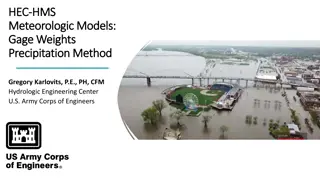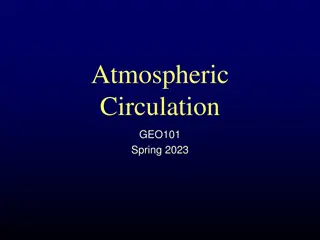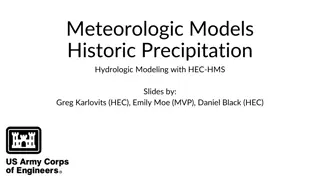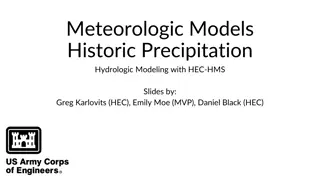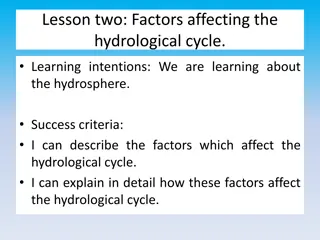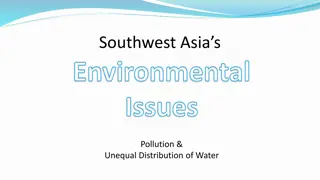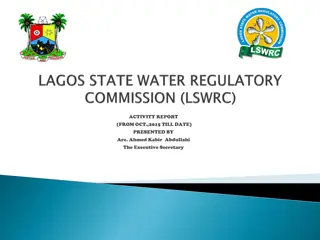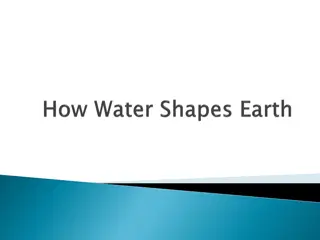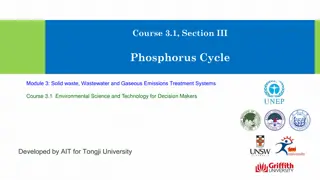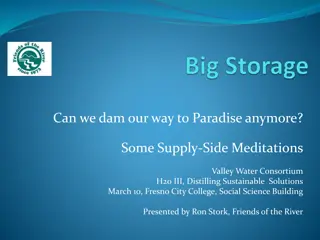Understanding the Hydrologic Cycle and Water Distribution
The hydrologic cycle, water distribution in the hydrosphere, water usage in the United States in 2005, condensation processes forming fog, cloud types, precipitation processes including ice-crystal and coalescence processes, and types of precipitation like sleet, freezing rain, hail, and graupel are discussed with informative images and descriptions.
Download Presentation

Please find below an Image/Link to download the presentation.
The content on the website is provided AS IS for your information and personal use only. It may not be sold, licensed, or shared on other websites without obtaining consent from the author. Download presentation by click this link. If you encounter any issues during the download, it is possible that the publisher has removed the file from their server.
E N D
Presentation Transcript
Fig 12.2 Hydrologic cycle. The numbers attached to the stages express each value as the volume of water divided by Earth surface area. Thus the values shown represent the depth of water (centimeters per year) associated with each mass transfer. All can be directly compared to the global average precipitation rate, which is about 100 cm/year.
Water in the Hydrosphere Most of the water is salt water in the ocean Most of the fresh water is locked up in ice sheets and glaciers Most of the liquid fresh water is in the ground Fig 12.3 Distribution of water in the hydrosphere. The middle and lower bars show the percentage distribution of the 2.8 percent of total hydrospheric water that is fresh. Of that freshwater component, only about one-tenth is easily available to humans.
Water Usage in the United States, 2005 Which states use the most water? Total water withdrawals (millions gallons per day) for the United States in 2005.
Condensation near the ground forms fog, a cloud in contact with the ground. As the ground and surface air cools to the dewpoint, water vapor condenses into a radiation fog (cooling by longwave radiation overnight) here in East Africa.
Cloud Types Schematic diagram of the different cloud types stratus, cumulus, and cirrus, arranged by their typical altitude.
Precipitation Processes The Ice-Crystal Process-requires the coexistence of ice and super-cooled water droplets in the cloud. Ice grows at the expense of water droplets that evaporate water molecules which adhere to the ice until they are large enough to fall as snow. If the air is warm enough, the snow melts and rain occurs. The Coalescence Process-requires different sizes of water droplets within warm clouds. Larger droplets grow by falling faster and sweeping up smaller droplets by coalescing until they are large enough to fall as rain. Source: http://collider.com/singin-in-the-rain-60th-anniversary-blu-ray-review/191992/
Types of Precipitation Besides rain and snow, there is: Sleet-melting ice that refreezes before reaching ground Freezing rain-melting ice that freezes on contact with a frozen surface Hail-ice particles that grow within clouds that have strong updrafts Graupel-soft, partially melted hail Source: http://climate.met.psu.edu/features/Hail/ PEMA_hail.php Four major forms of precipitation. (A) A rainstorm douses the Ponderosa Pine Forest near Flagstaff, Arizona. (B) Falling snow accumulates in south-central Alaska. (C) Freezing rain forms an icy coating on pine needles on a golf course in Wawona, near Yosemite National Park, California. (D) Golf-ball-sized hailstones litter the countryside following a storm in northern Texas.
Four Forms of Precipitation B A A-rainstorm B-snow C-freezing rain D-hail C D
Water Balance for Different Climates Range of water balance conditions found at the surface of Earth. (A) Baghdad, Iraq, experiences a constant deficit because potential evapotranspiration normally exceeds precipitation. (B) At Tokyo, Japan, the situation is reversed, and a constant water surplus is recorded. (C) At Faro, Portugal, the intermediate situation occurs, with a combination of surplus and deficit at different times of the year.
Water Balance Averages by Latitude Average annual latitudinal distribution of precipitation, evapotranspiration, and runoff in cm per year. The arrows show the direction of the water vapor flux by the atmospheric circulation.
Global Distribution of Annual Evaporation, Evapotranspiration Fig 12.10? Global distribution of annual evaporation and evapotranspiration in centimeters, with land elevations adjusted to sea level. Red isolines show the pattern over land; blue isolines over the oceans.
Global Distribution of Annual Precipitation Source: http://www-das.uwyo.edu/~geerts/cwx/notes/chap10/global_precip.html Global distribution of annual precipitation in millimeters/day.
Air Masses An air mass is a large body of air with relatively homogeneous character of temperature and humidity. Classification by latitude, moisture mT, mP, cA, cP, cT Movement and transitions-character of air masses can change as moves over different land surfaces, or crosses mountains, ie mP can become cP after crossing the Rockies, cP can become mT when moving over warm water. Source: https://www.meted.ucar.edu/sign_in.php?go _back_to=http%253A%252F%252Fwww.met ed.ucar.edu%252Ffire%252Fs290%252Funit7 %252Fprint_3.htm
North American Air Masses & Sources Source regions and common paths of the principal air masses that affect the continental United States.
Lifting Mechanisms That Produce Precipitation Convergence-when similar air masses converge, they are forced to rise, forming clouds Convection-surface heating causes warm air parcel to rise and form clouds Orographic-mountains and large obstacles force air to rise, forming clouds Frontal-when warm and cold air masses meet, cold air lifts warmer air forming clouds Source: http://keithrogershome.com/Chap7CldsPcpnFog.html
Lifting by Convergence Along the ITCZ warm trades meet and rise. Precipitation along the ITCZ shifts with season, into the summer hemisphere. Average daily rainfall rates (mm/day) for January and July based upon measurements from the Tropical Rainfall Measuring Mission (TRMM) satellite for the years 1998-2007.
Frontal Precipitation Vertical cross-section through a warm front (top) and cold front (bottom). The vertical scale is greatly exaggerated. Warm fronts typically have a 1:200 vertical- to-horizontal ratio; the ratio for cold fronts is approximately 1:70.
Convectional Precipitation Convection often leads to isolated showers from building cumulus clouds. Occasionally, these clouds grow large enough to form thunderstorms. Each thunderstorm cloud, cumulonimbus, has a life cycle of 3 stages. The three stages of the life cycle of an air mass thunderstorm: cumulus, mature, and dissipating. Updrafts dominate the developing stage, both updrafts and downdrafts are found during the mature stage, while only downdrafts are found during the dissipating stage. The approximate width at each stage of the thunderstorm is shown at the bottom.
Cumulonimbus grows near the Canadian Rockies in an afternoon thunderstorm. Source: http://www.physicalgeography.net/fundamentals/7t.html
Severe Thunderstorms Conceptual model of a severe thunderstorm producing sizeable hailstones. The red dashed lines represent the warm updrafts, the blue lines show the cold downdrafts, and the green lines represent the movement of hailstones. The thunderstorm is moving from left to right.
Orographic Precipitation Fig 13.7 Orographic precipitation on the upper windward slope of the Cascade Mountains in west-central Oregon. Note the significant temperature and moisture differences between the windward and leeward sides of this major mountain barrier. (Vertical scale is greatly exaggerated.)
Fig 13.8 Oregon s precipitation pattern, with the distribution of isohyets exhibiting the results of the orographic effect as westerly winds off the Pacific are forced across the north- south-trending Cascade Mountains. The transect across the Cascades between Eugene and Bend, diagrammed in Fig. 12.10, is marked by a red line.
Easterly Waves Easterly waves are disturbances within the trades that can produce heavy rainfall and potentially can form into tropical storms and hurricanes. Source: http://www.geography.hun ter.cuny.edu/~tbw/wc.note s/11.hurricanes/easterly_w ave_atl.htm The trough axis marks where the trades are converging with rising motion behind the westward moving wave, and where divergence and sinking motion occur ahead of the wave axis. Heaviest precipitation occur in the convergence zone, while mostly sunny conditions precede the axis.
Tropical Storms and Hurricanes Tropical cyclones can form over land or water, however hurricanes always develop over warm oceans. As cyclones increase their energy, their winds increase. Storms are defined by wind speed: Tropical Depression-winds below 40 mph Tropical Storm-winds 40 to 74 mph Hurricane-winds exceed 74 mph Hurricanes may form if 1. They occur over warm water-80F or 28C 2. There is an initial disturbance (ITCZ, convergence, mid-latitude cyclone 3. There is sufficient Coriolis force. Most hurricanes form in 8-15 degrees latitude 4. There are weak upper air winds. Strong flow destroys formation. Hurricanes can form over all tropical oceans where these conditions are met.
Fig 14.2 The eye of Hurricane Mitch is still over water, but this 1998 storm is poised to strike Central America and will become the costliest natural disaster in the modern history of the western hemisphere. Honduras will be hit hardest, with nearly 10,000 deaths When it is over, nearly one-quarter of the country s 6.4 million people will be homeless, and most of the agricultural economy will be ruined.
Fig 14.3 Cross-sectional view of a hurricane showing its mechanics and component parts.
Historic Tropical Storm and Hurricane Tracks Storm tracks of weak and severe tropical cyclones from 150 years through 2006. Weaker systems, shown in blue and yellow, occur near the Equator, during their early stages of development, and over land and in the middle latitudes as they lose energy and weaken. The steering of these systems by the easterly trade winds within the tropics, and the westerlies as they move into the middle latitudes is apparent. Category 4 and 5 hurricanes are most common in the western North Pacific Ocean.
Rossby Waves in the Upper Atmosphere Westerlies 500-mb map for North America in November. The lines show the height of the 500-mb level in meters above the surface (ex. 92 equals 5920 m). There is a ridge along the W. coast with troughs over central and E. coast US. Dashed lines are temperatures in Celsius.
Polar Jet Stream and Surface Weather Relationship between the Polar jet stream and surface pressure patterns. (A) Position of the jet stream 9000 m (30,000 ft) above North America. (B) Associated air movement around points X and Y in vertical cross section. (C) Resulting surface pressure conditions.
Life Cycle of a Mid-latitude Cyclone Source: http://www.geography.hunt er.cuny.edu/~tbw/wc.notes /9.weather.patterns/mid_cy clone_stages.htm


